Army Lists
Military Head Dress 1870 - 1904
1750 - 1810 | 1811
- 1830 | 1831 - 1852 | 1855
- 1869 | 1870 - 1904
| General's Cocked Hat |
|
5th (Royal Irish) Lancers
|
 |
|
| 1870 |
|
General and Staff Officers' cocked hats have varied but little
for nearly a century and then principally in the matter of height.
This hat is of black beaver, bound at each corner with black
oak leaf lace and with tassels of gold and crimson bullion at
each end. The various ranks of General and Staff Officers are
denoted by the length of the red and white swan feather plume
and the gold lace or cord ornament on the right side of the
hat. |
|
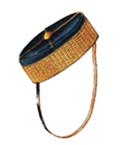 |
|
| Officer's Forage Cap 1870 |
|
All ranks of Lancers at this time wore small round forage caps,
with black leather chin straps. The cap was of the dark blue
cloth (scarlet in the 16th Lancers) with gold lace at the bottom
and gold cord up the sides and across the crown. In the centre
of the crown was a gold button in all Regiments except the 17th
Lancers. Yellow lace and cord were substituted for gold lace
for troopers. The cap was worn tilted over the right ear. |
| 60th Rifles (The King's Royal
Rifle Corps) |
|
5th (Northumberland Fusiliers)
Regiment of Foot |
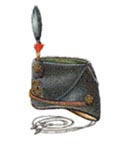 |
|
| Officer's Full Dress Busby 1873-78
|
|
In 1873 a fur busby replaced the shako hitherto worn. This busby
was of black lambskin for officers and of seal for other ranks,
the top being covered with dark rifle-green cloth. It was trimmed
with black cord, the ornaments being of dark bronze. In the
front above the regimental device, was a black silk corded bosswith
a bronze crown on it, the plume being black with a scarlet feather
base, though at the present time the plume is scarlet and the
base black. |
|
 |
|
| Officer's Full Dress Fur Cap 1874
|
|
In 1874 all Fusilier Regiments took into wear for all ranks
a fur cap of black racoon skin, 9 inches high, with a gilt grenade
in the front, bearing the regimental badge. The chin strap was
a gilt curb chain lined with black velvet. At this date the
Northumberland Fusiliers was the only Fusilier Regiment wearing
a plume, though subsequently plumes were authorized for all
other Fusilier Regiments. |
| 68th (Durham Light Infantry)
Regiment of Foot |
|
42nd (Royal Highlanders, The
Black Watch) Regiment of Foot |
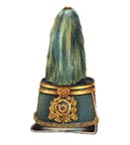 |
|
| Officer's Full Dress Shako 1874-81
|
|
Light Infantry Regiments at this time wore a shako covered with
dark grey-green cloth, with a row of gold braid at the bottom,
up the sides and back and two rows at the top. In place of the
braid at the top, Colonels and Lieutenant Colonels had two rows
of lace, and Majors one row. When first issued, a dark green
worsted ball tuft was worn in place of the drooping horse hair
plume. The gilt badge in front was of universal pattern, each
regiment having its own number in the centre of the bugle. |
|
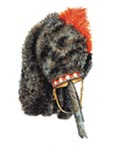 |
|
| Officer's Bonnet 1875 |
|
Except in size, the Highland feather bonnet has undergone little
change since the Highland Regiments came into the British Army.
At first a few feathers or tufts of black bearskin were attached
to the undress cap for ceremonial purposes. As more feathers
were added, the bonnet increased in height. The Black Watch,
the senior Highland Regiment, is the only one to wear the red
hackle, granted for services at Gildermalsen, 1795. All other
Highland Regiments wear a white hackle. |
| Grenadier Guards |
|
17th (The Leicestershire)
Regiment of Foot |
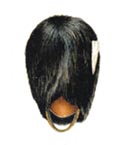 |
|
| Officer's Full Dress Bearskin
1875 |
|
Little description is needed of this head-dress, which has changed
very little since the early part of the nineteenth century.
During the first quarter of the last centurya gilt plate was
worn in front and cords and tassels of gold and crimson at the
side. The three regiments of Guards (there were only three at
this period) are distinguished by the plumes in their bearskins;
the Grenadiers wearing a white goat's hair plume on the left
side, the Coldstream a scarlet cut feather on the right, and
the Scots Guards no plume at all. |
|
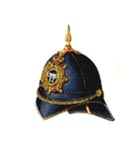 |
|
| Officer's Full Dress Helmet 1879-81
|
|
This head-dress, which was ordered for Line Regiments in 1879,
was of cork, covered with blue cloth (dark green for Light Infantry
and Rifles) with gilt ornaments (bronze for Rifles). The staf
was universal, each Regiment having its own number and badge
in the centre, mounted on coloured velvet, which in this particular
Regiment was black. For ranks other than officers the front
peak was bound with black leather and was rounded, not pointed.
|
| The Cameronians (Scottish
Rifles) |
|
The Royal Scots (The Lothian
Regiment) |
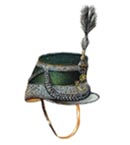 |
|
| Officer's Full Dress Shako 1894
|
|
A shako was authorized for this Regiment in 1894; the pipers,
however, wore the glengarry. This shako was covered with dark
green cloth with black patent leather peak and chin strap. Officers
wore a band of black silk lace round the top and bottom: black
silk cord in front and at the sides, and double cord round the
back; black silk square body line with egg mould and sliders,
and a plume of black feathers. Being a Rifle Regiment, all ornaments
are bronze. |
|
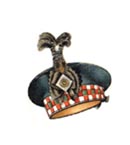 |
|
| Officer's Full Dress Kilmarnock
|
|
After having won a helmet for over 20 years, a head-dress of
more distinctively Scottish type was authorized for this regiment,
and also for the King's Own Scottish Borderers. This head-dress,
with its black cock's feather plume, is worn by all ranks except
pipers, who wear a glengarry. The bonnet is worn cocked on the
right side, and is of blue cloth with diced band and a black
silk rosette on the left side, on which is worn the regimental
badge. |
|